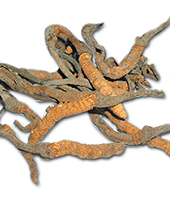Cordyceps
Cordyceps attracted public attention in 1993 when a group of Chinese runners who broke nine world records cre.

Cordyceps attracted public attention in 1993 when a group of Chinese runners who broke nine world records credited their performances to use of this mushroom. It is now consumed by both Olympian and professional athletes worldwide. It is not restricted as an athletic-enhancing substance because it is considered a food.
What is It?
Known also as "winter worm, summer grass" (dong chong xia cao), cordyceps is naturally found in the highlands of China, Tibet and Nepal above 10,000 feet. In early spring, people crawl on the ground to search for the small mushroom. It is literally a fungus that grows on the bat-moth caterpillar. Since it is very rare and expensive, Chinese scientists have found a way to cultivate it. The cultivated version is made from dried mycelia powder, usually grown on organic grain, so there are no animal byproducts in it.
How Does it Work?
Cordyceps' adaptogenic effect (which means it helps the body adapt to stress) is similar to ginseng but is two to three times stronger. The major active constituents are attributed to a group of polysaccharides that produce strong tonic effects, increase oxygen uptake in the lungs by opening up the bronchial tubes, while reducing bronchial inflammation and working as an expectorant.
Cordyceps will relieve exhaustion, night sweats and sexual impotency, and can also act as a sedative (due to its amino acid content). It will increase immune and anti-tumour function; reduce cholesterol (beneficially adjusting HDL/LDL ratio) and plasma triglycerides; and increase sperm production and sex drive. It will help improve heart arrhythmias (irregular heartbeat), chronic kidney problems, liver function after hepatitis B, tinnitus and uterine fibroids. Cordyceps has also been used as an antidote to opium addiction.
What Evidence Supports its Use?
For more than 1,000 years, cordyceps has enjoyed a well-deserved reputation for promoting vitality and endurance, restoring energy and slowing the aging process. There have been literally hundreds of scientific papers written on this fungus over the past 10 years. Modern research has confirmed that it enhances endurance and athletic performance, modulates the immune system, has anti-tumour properties, is a liver and nerve tonic, relaxes heart rate and causes short-term lowering of blood pressure, reduces total cholesterol and triglyceride levels, reduces platelet coagulation, increases libido in both sexes, increases oxygen intake and has anti-aging properties.
How Should I Take It?
Cultivated cordyceps comes in a capsule version that is cheaper and easier to administer than wild varieties. The Beijing Institute of Material Medica of the Chinese Medical Academy has shown in extensive studies that the cultivated version has the same chemical components and physiological effects as wild versions. Traditionally, cordyceps is usually combined with other herbs. I find it works best if mixed with reishi mushroom, so I often combine these two medicinal mushrooms as part of a supplement program. Normal dosage of cordyceps is one to two capsules, twice daily.
Caveats
Studies show this herb is safe to consume even at levels many times the recommended therapeutic dose.
The Bottom Line
Cordyceps has strong adaptogenic action, enhances vitality, endurance and energy, and is considered completely safe. Very large amounts have been consumed as food for a long period of time with no side-effects.




